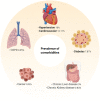The Impact of Pre-existing Comorbidities and Therapeutic Interventions on COVID-19
- PMID: 32903476
- PMCID: PMC7437504
- DOI: 10.3389/fimmu.2020.01991
The Impact of Pre-existing Comorbidities and Therapeutic Interventions on COVID-19
Abstract
Evidence from the global outbreak of SARS-CoV-2 has clearly demonstrated that individuals with pre-existing comorbidities are at a much greater risk of dying from COVID-19. This is of great concern for individuals living with these conditions, and a major challenge for global healthcare systems and biomedical research. Not all comorbidities confer the same risk, however, many affect the function of the immune system, which in turn directly impacts the response to COVID-19. Furthermore, the myriad of drugs prescribed for these comorbidities can also influence the progression of COVID-19 and limit additional treatment options available for COVID-19. Here, we review immune dysfunction in response to SARS-CoV-2 infection and the impact of pre-existing comorbidities on the development of COVID-19. We explore how underlying disease etiologies and common therapies used to treat these conditions exacerbate COVID-19 progression. Moreover, we discuss the long-term challenges associated with the use of both novel and repurposed therapies for the treatment of COVID-19 in patients with pre-existing comorbidities.
Keywords: COVID-19; SARS-CoV-2; comorbidities; immunology and infectious diseases; inflammation; inflammatory diseases; respiratory disease; virus immunity.
Copyright © 2020 Callender, Curran, Bates, Mairesse, Weigandt and Betts.
Figures




References
Publication types
MeSH terms
LinkOut - more resources
Full Text Sources
Miscellaneous

